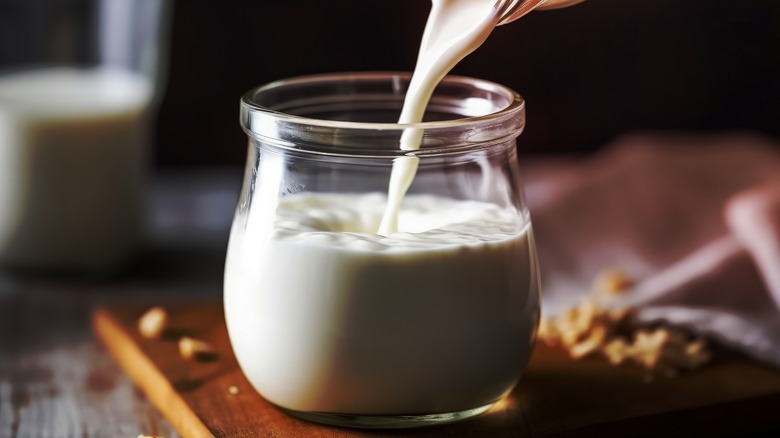How Long Does Buttermilk Usually Last After You Open It?
Think of buttermilk as regular dairy milk's thick, rich cousin. It's tangy, and (typically) cultured, and while it can definitely be enjoyed on its own, it often isn't. It's quite common for a quart of buttermilk to be opened for a one-off recipe, like a batch of buttermilk pancakes with lemon and ricotta – then, sadly, the remaining jug of buttermilk is left to languish in the fridge. But just how long can buttermilk sit there without spoiling? The short answer is about two weeks.
The longer answer is, of course, slightly more nuanced than 14 days. Buttermilk, if cultured, is much like yogurt in the sense that it's fermented and will therefore keep longer than uncultured dairy products. Unlike regular old whole milk (which is likely to go off within a matter of days), buttermilk, if stored properly, will go for weeks in the fridge and months in the freezer — if, that is, we're talking about typical buttermilk from your supermarket. Not all buttermilk is created equal, nor should it be treated as such.
Cultured vs. uncultured
The buttermilk you can buy at the grocery store is more or less purposefully spoiled milk — or, to put it more pleasantly, cultured. Cultured buttermilk is thick, sour, and gives your baked goods a light, airy quality because its lactic acid creates carbon dioxide when interacting with baking soda. Buttermilk cultures also allow it to stay good in the fridge for longer than regular milk. But because cultured buttermilk is essentially "spoiled," it can be hard to tell when it's actually gone off. When in doubt, smell it out: You'll know if you've got rotten buttermilk on your hands if it hits you in the face with a nasty scent.
Before refrigeration, milk kept at room temperature would go bad in a matter of hours. This funky counter milk is what butter was often made from. If you've ever churned butter at home, you'll know that the byproduct of this process looks like 2% milk. It's a bit thin and tastes like milk with a buttery aftertaste. Notably, it doesn't have that tanginess that buttermilk is known for, but is still technically buttermilk. The important difference between this butter byproduct and store-bought buttermilk is that the byproduct buttermilk isn't cultured unless you know how to culture it yourself — a process similar to making yogurt. Uncultured buttermilk can be used in baking, but it won't have the same leavening qualities. The shelf life of uncultured buttermilk is comparable to regular milk — you're looking at a week in the fridge tops.
Freezing and refrigerating buttermilk
Buttermilk can (and should be) used in all manner of baked goods, from classic buttermilk vanilla cake to good old-fashioned buttermilk biscuits. But while buttermilk is ideal for baking, you can use it for all kinds of recipes, not just baked goods. Keeping some around is a great idea, then — but despite its many applications, you still might find that you have more buttermilk than you know what to do with. Go ahead and freeze it and it will keep for up to three months.
If you have unopened buttermilk in the fridge and it's past its expiration date, don't fret. Buttermilk can still remain good for up to an additional two weeks after its stamped date of expiration. Extra-funky buttermilk can be used too; buttermilk pie is a deeply satisfying dessert that relies on the rich, sour qualities of buttermilk and pairs beautifully with a tart fruit compote. If your buttermilk is chunky, smells hideous, or has signs of mold, then it's definitely time to ditch it — but until it comes to that, embrace the funkiness.


